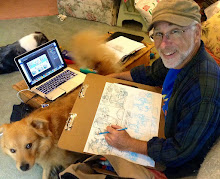
I have been an intermittent reader of the Sunday funnies as printed in the NYTimes magazine, but not much of a fan. Leave it to the Times to take all of the lower east side ruff -n-tumble out of the comics and dress'em up and slick back their hair for presentation to society-folk uptown.
The Funnies weren't good enough for the Times, they had to wait until comics had been officially declared "Art" by the rest of the world before presenting them to mother. (And not on newsprint either-might soil your hands.)
That being said, of the many excellent cartoonists given audience in those pages in the last few years, none has fared better within the weekly format than Seth, whose contribution, "George Sprott", has just been collected in a beautiful package by Drawn & Quarterly.
I had been eagerly anticipating a "Sprott" collection, and somehow thinking it was to take the humble format of "Wimbeldon Green" , I was not prepared for the oversize book I finally held in my hands. To cut to the chase( for those who have lives), this is a terrific book, gorgeous to behold and far surpassing my expectations. It very well may be Seth's best work yet, it is certainly my favorite. Go buy it now.
Seth is one of those few cartoonists whose visual style is so perfectly suited to his literary pre-occupations you might have thought he worked it up as some graduate thesis in post-modern aesthetics. But rather than some distant academic pursuit, total immersion in "style" is an absolute necessity of life for Seth, a compulsion thoroughly examined in "It's a Good Life if You Don't Weaken", his first book.
That pre-occupation has something to do with style-not as fuel for nostalgic reverie, but as signifier of a futile quest-to come to terms with life's passing, and to grasp something solid from the sand that slips through the hourglass. There is no stopping time, but in the post-modern era, style is all that is left to us. Movie set designers have made careers out of reconstructing the look of the past in exacting detail-masterfully manipulating the cultural signifiers of memory and loss( was the world ever sepia-tone? Or black and white?) and we accept that manipulation as not only pre-requisite for a journey to an historical period , but as some kind of proof of authenticity-as if the "authentic past" were something tangible, something verifiable in experience.
In "George Sprott" , as well as in "Wimbeldon Green" , Seth's visual style presents as an apparent pastiche of some undefinable past manner of the cartoon-whether from the back pages or side bars of magazines from the '40's or '50's, or the gag cartoons of "The New Yorker" -we're never exactly sure. While at the same time, that style, both in surface and substance, is absolutely contemporary, impossible to conceive of in any other era. In Seth's visualizations the past is fuzzy and indistinct, yet it is right there- forever present and out-of reach.
And what is wonderful in "George Sprott"-and I think a grand achievement amidst Seth's body of work, is the application of this approach- with all of its contradictions- in the service of portraiture. For Sprott too, is right there; given to us in fits and starts, in broad, sweeping strokes-as detailed a portrait as any of us is ever likely to receive-and yet Sprott remains unknowable, an unresolved tangle of reminiscences.
Television has become one the major repositories of cultural memory, we judge entire eras by their television "look"-(as if all of the Sixties really looked like "The Mamas and the Papas" on the Ed Sullivan show, and the Seventies like "the Brady Bunch" and "Charlie's Angels") and Seth's lead character is aptly enough, a television personality of the 1960's. Fittingly, all of the tapes for his shows have been lost, and so, that particular past, which would necessarily dominate all other pasts competing to define George Sprott, is left to be filled in by the voices of the interviewees; the friends, colleagues and relatives who tell his story. What are we missing without these video tapes? The suggestion is-- that while the TV shows are a tantalizing missing piece of the puzzle --not much. The essence of a life, lies beyond television's capabilities-and well beyond that of any single memory. We think we know Ed Sullivan, Robert Young, George Reeves. But what do we know? An image, a phantom, splayed out upon a screen in endless repetition.
How many times have we watched dvds of some obscure television show from our childhood, in the vain, unspoken hope that via the flickering images on the screen we might touch, feel, smell -something of that we have lost? Like the character in Jack Finney's "Time and Again" we
think by laying out the artifacts of a period past we might construct a time machine--as if time were merely some intellectual construct, rather than biological necessity.
The narrator of Seth's masterwork speaks simply and eloquently of time, and in so doing sums up the cartoonist's ambition and achievement: "...Maybe it's like these funnies..."


No comments:
Post a Comment